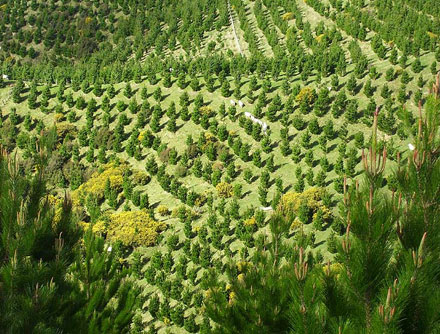
A Marlborough New Zealand forestry consultant supports an increase in the value of carbon credits to encourage more trees to be planted. Source: The Marlborough Express
Latest Ministry of Primary Industries figures show the total area of forest planted in New Zealand had fallen by 16,000 hectares, with only 3000ha of new forest planted last year.
Forestry was the country’s third biggest exporter, behind meat and wool, and dairying, with an export value worth NZ$4.8 billion in 2014. But since 2000 the planted area had declined on average 3267ha a year, from 1.76 million hectares down to 1.72 million hectares last year.
In contrast, from 1955 to 2000 the total forest area in New Zealand grew 344,000ha to 1.79 million hectares, or 31,667ha each year for 45 years.
Almost 10,000ha of harvested forest was also lying fallow waiting for landowners to replant.
Since 2012 the total area of forest in Marlborough and Nelson has fallen slightly from 168,585ha to 168,421ha, despite a rise in 2013 to 170,171ha, Forestry Owners Association figures show.
Forestry consultant Vern Harris said increasing the value of carbon credits would encourage landowners to reach a decision earlier on whether to plant not only radiata pine, but other sorts of species.
“Marlborough has not been as badly affected as some regions, nor as much as the Nelson forest area,” Mr Harris said.
“The region has moved ahead, albeit at a very low level, each year due to the fact that almost all of our harvest areas are re-established, and we do not have large areas deforested and converted to other uses, such as housing subdivisions.
“While the bulk of the reductions had happened in Nelson, the bulk of the harvesting in Marlborough had been replanted and this had led to less decrease in total forest area.”
Marlborough’s forest industry would like to see 100,000ha planted in the region eventually, up from the latest estimate of 78,000ha, he said.
One way to increase the area of plantings would be to raise the value of carbon credits.
“The Emission Trading Scheme should be a major factor in the establishment of a forest but we should also be careful not to over emphasise it as some forests will have limited production,” he said.
“The world needs wood, and we have the capability to produce it quickly and efficiently.”
Mr Harris said one of the obstacles to encouraging more forest being replanted was investors’ desire to see a quicker return.
“Many are not prepared to wait 30 years until the trees are harvested,” he said.
“People want a short investment return.
“As well, the three yearly political cycle does not make investing in forests attractive because the rules can change so often over the rotation period it becomes unsettling for many.”
Forest Owners Association technical manager Glen Mackie said raising the value of carbon credits to encourage more forest area being planted would be “a game changer” for the industry.
Mr Mackie said the shrinking area of forests was “predictable” and likely to fall further until the cost of land could be justified by the income it generated.
Long term forestry was more profitable than sheep and cattle on a lot of second class hill country, Mr Mackie said.
“It is particularly profitable for established growers with good infrastructure, as well as for new forest owners on land that has good road access and is near to a port or processor.”
A steady income from carbon credits would overcome obstacles to planting new forests, such as the cost of land, and lack of income from forests until harvesting, he said.
Raising the value of carbon credits to $15 tonne would be a game change. Mr Mackie said if the ETS 50% subsidy was removed for existing carbon emitters it would provide an incentive to reduce emissions and plant more trees.
“A meaningful price for carbon will not only tell landowners and the rest of the world that New Zealand takes climate change and reducing carbon emissions seriously, it will ensure that future generations get the environmental and other benefits of a vibrant forest industry,” Mr Mackie said.





